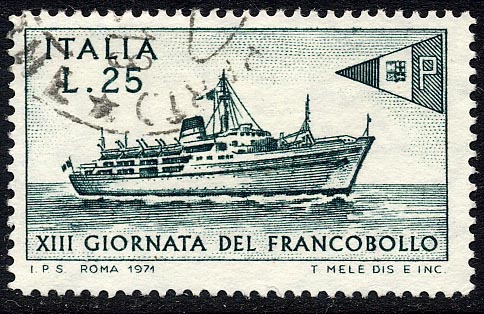Stanley Gibbons in “Collect Ships on Stamps” give the name of the vessel as TIRRENIA, but this is wrong, that is the name of the company. The correct name is CITTA DI NAPOLI.
Built as a passenger-cargo vessel under yard No 631 by Navalmeccanica in Castellammare di Stabia, Italy for Tirrenia S.P.A. di Navigazione, Naples.
14 March 1960 ordered.
15 June 1960 laid down.
12 November 1961 launched as the CITTA DI NAPOLI one sister the CITTA DI NUORO.
Tonnage 5,735 grt, 3,196 net, 1,079 dwt, dim. 120.5 x 16.8 x 5.41m (draught).
Powered by 2 FIAT 9-cyl. C 609 TS engines, 12,600 horsepower, 12,600 bhp, twin pitch propellers, speed 19.5 knots.
Cargo capacity in two holds 990m³. and 32 cars.
Capacity 1200 passengers, 182 cabins, and 99 crew.
23 July 1962 delivered to owners, homeport Naples, IMO 5073313.
The Città class was made up of two units in service for the Tirrenia company from 1962 to 1987. The ships, christened with the names CITTÀ DI NAPOLI and CITTA DI NUORO, were built at the Navalmeccanica shipyards in Castellammare di Stabia in 1961 and 1962.
During the 1950s, Tirrenia di Navigazione put eight new freight-passenger units into service, the five belonging to the Region class , the sister ships Arborea and Caralis and the Torres . The demand for internal transport, however, grew at a rapid pace and soon required the commissioning of new units, in particular to complete the Civitavecchia - Olbia section . Taking advantage of the tax relief for shipbuilding granted by the so-called "Tambroni Law" of 1954, in 1959 Tirrenia carried out the preliminary project of two mixed cargo-passenger units, assigning the detailed project and construction to Navalmeccanica of Castellammare di Stabia the following year.
Features: The two units could carry up to a maximum of 1200 passengers and were characterized by various innovations compared to the ships put into service by Tirrenia up to that moment. One of the main innovations was the abolition of the third class and related common dormitories; with the intention of guaranteeing the greatest possible number of passengers a fixed accommodation during the journey, first and second class armchair lounges were introduced; precisely the presence on board of a large number of reclining seats earned the two units the nickname of "coach ships" In total, the ships had 103 first-class cabins (with a total of 165 berths), 79 second-class cabins (with 282 berths) and 14 armchair rooms (two of "super first class", five of first class and seven second class) with a total of 530 seats. There were also, as usual, two cabins for possible detainees and for the carabinieri escort. The furnishings of the public rooms reserved for the first class were designed by the well-known architect Gustavo Pulitzer-Finali. The common areas available to passengers included a 72-seat restaurant and a living room-bar, to which a second was added in 1968 by eliminating two armchair lounges.
The units were equipped with two forward holds with a total capacity of 990 m³. At the bow there was also a garage with a capacity of 32 cars, which could be loaded with the use of two side doors and mobile slides; an additional space for cars was then created aft, on deck. The propulsion was ensured by two four-bladed variable-pitch propellers, each driven by a FIAT C 609 TS nine-cylinder two-stroke diesel engine, directly connected to the shaft. Even the use of two-stroke engines was a novelty compared to previous ships, on which four-stroke engines were mounted connected to the propeller shafts with electromagnetic couplings.The engines each developed a power of 6,300 horsepower, guaranteeing a cruising speed of 19.5 knots; this made it possible to reduce the times of the Civitavecchia - Olbia crossing from eight to seven hours.
Service
The CITTA DI NAPOLI was laid down on June 15, 1960 on the slipways of the Castellammare di Stabia shipyard, launching for the first time on November 12, 1961. After sea trials, she was delivered to Tirrenia on 24 July 1962. The twin CITTA DI NUORO was instead laid down, in the shipyard of Ancona, on 25 June 1960. The launch took place on 16 June 1962, while the delivery took place on 4 August 1962.
Both ships were immediately destined for the Civitavecchia - Olbia line for which they had been designed. In 1978, following the entry into service of the new units of the class POETA DELEDDA and VERGA, both ships were laid up. From this moment on, the CITTA DI NAPOLI and the CITTA DI NUORO alternated between long periods of laid up and sporadic returns to service, especially during the high season. Both ships were used, between 1980 and 1981, as accommodation for the displaced people of the 1980 Irpinia earthquake. In 1984 the CITTA DI NAPOLI and the the CITTA DI NUORO were used for a very short time on a connection between Cagliari and Sant'Antioco , an extension of the Civitavecchia - Cagliari line. From December 1985 to March 1986 the two ships were used to house the citizens of Naples displaced following the explosion of the Agip deposit.
In 1988, after a few years of decommissioning in Palermo, the CITTA DI NAPOLI and the CITTA OF NUORO were sold to Bulkitalia of Genoa for demolition.
She were broken up by Acciaierie e Ferriere di Porto Nogaro in August 1988.
https://it.wikipedia.org/wiki/Classe_Ci ... %281962%29 (Google translated)
Italy 1971 25Lire sg1303, Scott 1054

